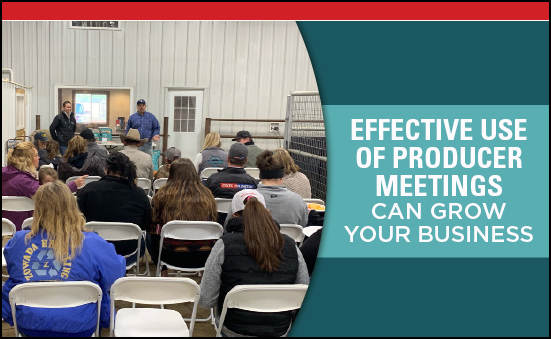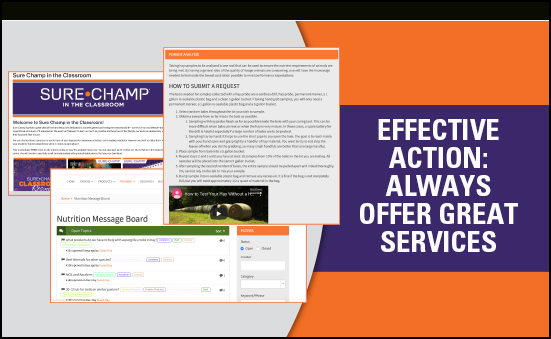Any time you get a group of like-minded people in a room to talk about solving their challenges, you will likely have a successful producer meeting. However, you can use the relationships you have already established to create an even more fruitful meeting. There are a few ways that using existing relationships when planning your next producer meeting can help build your business. Let’s explore.
- Cooperate with another agricultural company.
Have you considered co-hosting your next producer meeting with another complementary agricultural company? Sure, the companies might have some overlap in customers, but you each will likely have some unique customers who could benefit from the other company’s products and services. Perhaps you could partner with an animal health company. And, for those young producers who are interested in show livestock, you might feature the Sure Champ® and Vita Charge® products during a youth workshop co-hosted by one of the show supply companies.
Area Sales Manager Ty McGuire said he likes to work with animal health companies who have the same goals for their customers as he does when planning a producer meeting. He adds that another benefit to cooperating with hosting these meetings is the cost savings since both companies will be sharing in the meal costs.
Building on these already established relationships gives you a leg up. It shows your potential customers that you are easy to get along with. It also provides an unspoken endorsement on the products and services you provide.
- Encourage your customers to bring a guest.
Your customers are already likely attending, but you could offer an incentive for bringing a guest who has the potential to become a new customer. McGuire said he will go through his contacts the week before a meeting and text everyone within a 30-mile radius with a reminder about the meeting and encourage them to bring a guest. He likes to raffle off a product at the end of the meeting, which serves a dual purpose. First, it gets the attendees excited and engaged; next, it provides McGuire and the host dealer new names with contact information to follow up with.
“I like to raffle something off. It gives everyone an incentive to bring a guest. A 50-pound stress tub is the perfect raffle item. It’s something everybody can use,” he said.
- Engage with the audience.
McGuire said he has a pretty good handle on the crowd before the meeting starts because he has either built a relationship with the customers through the dealers or met the customers during the meal. Once he starts his presentation, which he always begins by talking about Amaferm®, he will use the attendees’ names and engage with them during the presentation. He said calling them out by name and talking about their specific operation – cow/calf, club lamb, etc. – helps build trust and respect between those in attendance and himself.
- Call upon your allies.
Word-of-mouth and testimonials go a long way in building trust and securing new customers. McGuire said he likes to have a veterinarian who either uses the products or is familiar with the products at each meeting and will extend a personal invitation to ensure his or her attendance. Veterinarians are trusted resources who will speak up about a product’s benefits and substantiate how the products work. It is also a good idea to have a well-respected producer who has had good results give a testimonial if they are attending. McGuire said he’s found he can build trust with prospects because of his own experiences in his own cattle operation.
Producer meetings are an efficient way to show appreciation to current customers and establish relationships with potential customers. Building on current relationships at these meetings makes them even more effective and gives the dealer a leg up in building their business. Like any other enterprise, use your resources, count on your relationships and use those relationships to grow your customer base.









